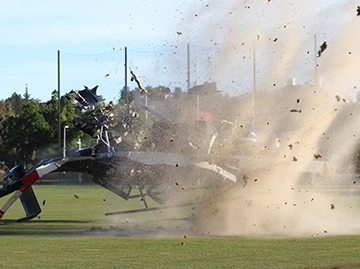While repositioning, the pilot commenced lifting this Bell 206L-1 helicopter into a hover from a temporary helipad. It started rolling about the right skid until the main rotor blades struck the ground.

On 2 November 2013, the pilot of a Bell 206L-1 helicopter, registered VH-VDZ, was conducting passenger-carrying charter operations between Olympic Park oval and Flemington Racecourse, Melbourne, Victoria. At about 1830 Eastern Daylight-saving Time, the pilot prepared to reposition the helicopter from one of the temporary helipads at Olympic Park. There were no passengers on board.
As the pilot lifted the helicopter into a hover it started rolling about the right skid, which was in contact with the ground. The helicopter rapidly rolled further right until the main rotor blades struck the ground. A large amount of main rotor and other high energy debris was released from the helicopter and impacted a nearby marquee, a number of vehicles and a helicopter on an adjacent helipad. The pilot sustained minor injuries.
The ATSB found that the pilot did not identify and react to the helicopter’s right-skid low attitude in sufficient time to prevent the helicopter rolling over. In addition, an unsecured ballast bag was positioned on the left front floor of the helicopter, increasing the risk of injury to occupants. Further, the helicopter’s dual flight controls were removed to facilitate the flights. The person who removed the controls did not have the training or authorisation to conduct the maintenance procedure. The left cyclic stub cover was not installed, leaving the stub exposed. This resulted in the potential for the ballast bag to inhibit movement of the pilot’s cyclic control due to fouling of the left cyclic stub.
The ATSB identified safety issues relating to the availability of first aid and emergency response equipment at the oval and the proximity of the helipads to the perimeter fence and public access areas. Each increased the risk of injury to bystanders in the event of an accident.
For subsequent operations at the Olympic Park oval for the remainder of the event, the charterer positioned firefighting equipment at each helipad and first aid equipment was made available nearby. In addition, the helipads were repositioned further from the passenger marquee, and passengers were not loaded or unloaded if helicopters were in the process of landing or taking-off from adjacent helipads. Operations at the Olympic Park oval ceased following the 2013 carnival.
Safety message
This accident highlights the importance of coordinated control inputs by pilots during lift-off to control any roll, and if necessary smoothly lowering the collective in coordination with cyclic input to re‑establish the helicopter’s weight evenly on the ground before any roll becomes excessive. The importance of properly securing any equipment, particularly if stowed in aircraft cockpits, and of the correct removal and re-fitting of dual flight controls to prevent any obstruction or fouling of the controls is emphasised.
In addition, this accident is a reminder of the risks involved when operating helicopters in public areas. Although the likelihood of a helicopter accident on the ground that results in injuries was found by the ATSB to be low, in the event of an accident, high energy rotor and other debris can travel large distances. Where possible, operators should consider larger distances around helicopter landing areas, in particular when operating close to public areas.
Read the report: Collision with terrain involving Bell 206L helicopter, VH-VDZ, at Melbourne, Victoria, on 2 November 2013


